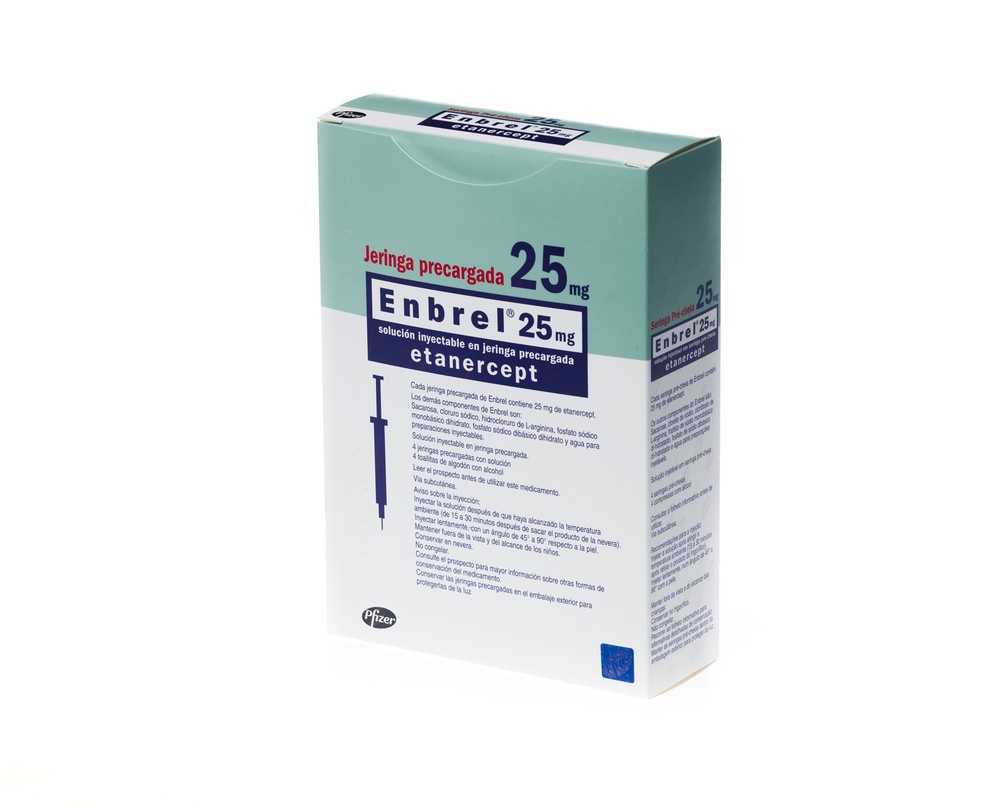
Инструкция по применению ЭНБРЕЛЬ 25 мг РАСТВОР ДЛЯ ИНЪЕКЦИЙ В ПРЕДНАПОЛНЕННЫХ ШПРИЦАХ
Введение
Проспект: информация для пользователя
Энбрел 25 мг раствор для инъекцийвпредварительно заполненном шприце
Энбрел 50мг раствор для инъекцийвпредварительно заполненном шприце
этанерцепт
Прочитайте внимательно весь проспект перед началом использования этого лекарственного средства, поскольку он содержит важную информацию для вас.
|
Содержание проспекта
Информация, представленная в этом проспекте, организована в следующие 7 разделов:
- Что такое Энбрел и для чего он используется
- Что необходимо знать перед началом использования Энбрела
- Как использовать Энбрел
- Возможные побочные эффекты
- Хранение Энбрела
- Содержание упаковки и дополнительная информация
- Инструкции по применению
1. Что такое Энбрел и для чего он используется
Энбрел - это лекарственное средство, изготовленное из двух человеческих белков. Он блокирует активность другого белка, который находится в организме и вызывает воспаление. Энбрел действует, уменьшая воспаление, связанное с определенными заболеваниями.
Энбрел может использоваться для лечения ревматоидного артрита средней или тяжелой степени, псориатического артрита, аксиального спондилоартрита тяжелой степени, включая анкилозирующий спондилит и псориаз средней или тяжелой степени, обычно в зависимости от каждого случая, когда другие методы лечения не были достаточно эффективными или не подходят для вас.
При лечении ревматоидного артрита Энбрел обычно используется в комбинации с метотрексатом, хотя также может использоваться как единственное лекарственное средство в случае, когда лечение метотрексатом не подходит для вас. Энбрел может замедлить повреждение, вызванное ревматоидным артритом, в ваших суставах и улучшить вашу способность выполнять повседневные действия, как при использовании в одиночку, так и в комбинации с метотрексатом.
В случае пациентов с псориатическим артритом с множественным поражением суставов Энбрел может улучшить вашу способность выполнять повседневные действия. В случае пациентов с множественными симметричными, опухшими или болезненными суставами (например, в руках, запястьях и ногах) Энбрел может задержать прогрессию структурного повреждения этих суставов, вызванного заболеванием.
Энбрел также показан для лечения детей и подростков с следующими заболеваниями:
- Для следующих типов ювенильного идиопатического артрита, когда лечение метотрексатом не было эффективным или не подходит для них:
- Полиартрит (с положительным или отрицательным ревматоидным фактором) и расширенная олигоартрит у пациентов от 2 лет.
- Псориатический артрит у пациентов от 12 лет.
- Для артрита, связанного с энтезитом, у пациентов от 12 лет, для которых использование других, более часто применяемых методов лечения не было эффективным или не подходит для них.
- Тяжелый псориаз у пациентов от 6 лет, которые имели недостаточный ответ на фототерапию или другие системные методы лечения.
2. Что необходимо знать перед началом использования Энбрела
Не используйте Энбрел
- если вы или ребенок, находящийся на вашем попечении, аллергичны к этанерцепту или любому другому компоненту Энбрела (перечисленному в разделе 6). Если вы или ребенок испытываете аллергические реакции, такие как сдавление грудной клетки, одышка, головокружение или сыпь, не вводите больше Энбрела и немедленно проконсультируйтесь с вашим врачом.
- если вы или ребенок страдаете или имеете риск развития тяжелой инфекции крови, называемой сепсисом. Если вы не уверены, проконсультируйтесь с вашим врачом.
- если вы или ребенок страдаете любой инфекцией. Если вы не уверены, проконсультируйтесь с вашим врачом.
Предостережения и меры предосторожности
Проконсультируйтесь с вашим врачом перед началом использования Энбрела.
- Аллергические реакции:Если вы или ребенок испытываете аллергические реакции, такие как сдавление грудной клетки, одышка, головокружение или сыпь, не вводите больше Энбрела и немедленно проконсультируйтесь с вашим врачом.
- Инфекции/хирургия:Если вы или ребенок развиваете новую инфекцию или собираетесь пройти крупную хирургическую операцию, ваш врач может захотеть контролировать лечение Энбрелом.
- Инфекции/диабет:Сообщите вашему врачу, если вы или ребенок имеете историю повторяющихся инфекций или страдаете диабетом или другими заболеваниями, которые увеличивают риск инфекции.
- Инфекции/мониторинг:Сообщите вашему врачу о любой недавней поездке за пределы европейского региона. Если вы или ребенок развиваете симптомы инфекции, такие как лихорадка, озноб или кашель, немедленно сообщите об этом вашему врачу. Ваш врач должен решить, продолжать ли мониторинг вас или ребенка на предмет инфекций после прекращения лечения Энбрелом.
- Туберкулез:Поскольку были зарегистрированы случаи туберкулеза у пациентов, лечившихся Энбрелом, ваш врач осмотрит вас на предмет признаков и симптомов туберкулеза перед началом лечения Энбрелом. Это может включать тщательный анализ вашей медицинской истории, рентгенографию грудной клетки и тест на туберкулез. Проведение этих тестов должно быть записано в Карточке информированного пациента. Очень важно, чтобы вы сообщили вашему врачу, если вы или ребенок имели туберкулез или были в прямом контакте с кем-то, кто имел туберкулез. Если симптомы туберкулеза (такие как постоянный кашель, потеря веса, апатия, умеренная лихорадка) или любая другая инфекция появляются во время или после лечения, немедленно сообщите об этом вашему врачу.
- Гепатит Б:Сообщите вашему врачу, если вы или ребенок имели гепатит Б в прошлом. Ваш врач проведет тест на гепатит Б перед началом лечения Энбрелом. Лечение Энбрелом может реактивировать гепатит Б у пациентов, которые ранее были инфицированы вирусом гепатита Б. Если это происходит, необходимо прекратить использование Энбрела.
- Гепатит С:Сообщите вашему врачу, если вы или ребенок страдаете гепатитом С. Ваш врач может захотеть контролировать лечение Энбрелом в случае, если инфекция ухудшится.
- Расстройства крови:Немедленно сообщите вашему врачу, если вы или ребенок испытываете симптомы, такие как постоянная лихорадка, боль в горле, синяки, кровотечение или бледность. Такие симптомы могут указывать на наличие серьезной проблемы с кровью, которая требует прекращения лечения Энбрелом.
- Расстройства нервной системы и зрения:Сообщите вашему врачу, если вы или ребенок страдаете рассеянным склерозом, невритом зрительного нерва (воспалением зрительного нерва) или трансверзитом миелита (воспалением спинного мозга). Ваш врач решит, подходит ли Энбрел для лечения.
- Сердечная недостаточность:Сообщите вашему врачу, если вы или ребенок имеете историю сердечной недостаточности, поскольку Энбрел должен использоваться с осторожностью в этих обстоятельствах.
- Рак:Сообщите вашему врачу, если вы имели лимфому (тип рака крови) или любой другой рак до начала лечения Энбрелом.
Пациенты с тяжелым ревматоидным артритом, которые имели это заболевание в течение долгого времени, могут иметь более высокий риск развития лимфомы по сравнению со средним.
Дети и взрослые, принимающие Энбрел, могут иметь повышенный риск развития лимфомы или других видов рака.
Некоторые подростки и дети, получавшие Энбрел или другие лекарственные средства, действующие подобно Энбрелу, развили рак, включая редкие виды, которые иногда приводили к летальному исходу.
Некоторые пациенты, получавшие Энбрел, развили рак кожи. Сообщите вашему врачу, если вы или ребенок испытываете любые изменения в коже или росты на коже.
- Ветряная оспа:Сообщите вашему врачу, если вы или ребенок были подвержены ветряной оспе во время использования Энбрела. Ваш врач определит, необходимо ли профилактическое лечение от ветряной оспы.
- Латекс:Колпачок иглы сделан из латекса (сухой натуральный каучук). Проконсультируйтесь с вашим врачом перед использованием Энбрела, если колпачок иглы будет манипулирован или если Энбрел будет введен кому-то с известной или возможной аллергией на латекс.
- Алкоголизм:Энбрел не должен использоваться для лечения гепатита, связанного с алкоголизмом. Пожалуйста, сообщите вашему врачу, если вы или ребенок, находящийся на вашем попечении, имеете историю алкоголизма.
- Гранулематоз Вегенера:Энбрел не рекомендуется для лечения гранулематоза Вегенера, редкого воспалительного заболевания. Если вы или ребенок, находящийся на вашем попечении, страдаете гранулематозом Вегенера, обсудите это с вашим врачом.
- Противодиабетические лекарственные средства:Сообщите вашему врачу, если вы или ребенок страдаете диабетом или принимаете лекарственные средства для лечения диабета. Ваш врач может решить, что вам или ребенку необходимо меньше противодиабетических лекарственных средств во время приема Энбрела.
Дети и подростки
Вакцинация:Если возможно, дети должны быть привиты против всех необходимых заболеваний перед началом использования Энбрела. Некоторые вакцины, такие как пероральная вакцина против полиомиелита, не должны вводиться во время использования Энбрела. Проконсультируйтесь с вашим врачом перед использованием любой вакцины.
Обычно Энбрел не должен использоваться у детей младше 2 лет с полиартритом или расширенной олигоартритом, у детей младше 12 лет с артритом, связанным с энтезитом, или псориатическим артритом, и у детей младше 6 лет с псориазом.
Другие лекарственные средства и Энбрел
Сообщите вашему врачу или фармацевту, если вы или ребенок используете, недавно использовали или могут использовать любое другое лекарственное средство (включая анакинру, абатацепт или сульфасалазин), даже если оно не было назначено вашим врачом. Вы или ребенок не должны использовать Энбрел вместе с лекарственными средствами, содержащими активные вещества анакинра или абатацепт.
Беременность и лактация
Энбрел должен использоваться во время беременности только в случае явной необходимости. Проконсультируйтесь с вашим врачом, если вы беременны, думаете, что можете быть беременной или планируете беременность.
Если вы получали Энбрел во время беременности, ваш ребенок может иметь более высокий риск инфекций. Кроме того, в одном исследовании было обнаружено больше врожденных дефектов, когда мать получала Энбрел во время беременности по сравнению с матерями, которые не получали Энбрел или другие подобные лекарственные средства (антагонисты TNF), но не было выявлено никакого закономерности в типах врожденных дефектов. Другое исследование не обнаружило повышенного риска врожденных дефектов, когда мать получала Энбрел во время беременности. Ваш врач поможет вам решить, превышают ли преимущества лечения потенциальный риск для вашего ребенка.
Проконсультируйтесь с вашим врачом, если вы хотите кормить грудью во время лечения Энбрелом. Важно, чтобы вы сообщили педиатру и другим медицинским работникам об использовании Энбрела во время беременности и лактации до того, как ваш ребенок получит любую вакцину.
Вождение и использование машин
Не ожидается, что использование Энбрела повлияет на вашу способность управлять транспортными средствами и работать с машинами.
Энбрел содержит натрий
Это лекарственное средство содержит менее 1 ммоль натрия (23 мг) на единицу дозы; это означает, что оно практически не содержит натрия.
3. Как использовать Энбрел
Следуйте точно инструкциям по введению этого лекарственного средства, указанным вашим врачом. В случае сомнений проконсультируйтесь с вашим врачом или фармацевтом.
Если вы считаете, что действие Энбрела слишком сильное или слишком слабое, сообщите об этом вашему врачу или фармацевту.
Предварительно заполненный шприц доступен в дозах 25 мг и 50 мг.
Дозировка для взрослых пациентов (в возрасте 18 лет и старше)
Ревматоидный артрит, псориатический артрит и аксиальный спондилоартрит, включая анкилозирующий спондилит
Обычная доза составляет 25 мг, вводимых дважды в неделю, или 50 мг, вводимых один раз в неделю, в виде подкожной инъекции. Однако ваш врач может определить альтернативную частоту введения Энбрела.
Псориаз в виде бляшек
Обычная доза составляет 25 мг дважды в неделю или 50 мг один раз в неделю.
Альтернативно, могут вводиться 50 мг дважды в неделю в течение максимум 12 недель, за которыми следует 25 мг дважды в неделю или 50 мг один раз в неделю.
Ваш врач решит, как долго вы должны принимать Энбрел и нуждается ли в повторении лечения в зависимости от вашего ответа. Если Энбрел не оказывает эффекта на ваше заболевание после 12 недель, ваш врач может порекомендовать прекратить использование этого лекарственного средства.
Использование у детей и подростков
Адекватная доза и частота дозирования зависят от веса тела и заболевания ребенка или подростка. Ваш врач определит адекватную дозу для ребенка и назначит наиболее подходящую форму Энбрела (10 мг, 25 мг или 50 мг).
Для полиартрита или расширенной олигоартрита у пациентов от 2 лет, или артрита, связанного с энтезитом, или псориатического артрита у пациентов от 12 лет, обычная доза составляет 0,4 мг Энбрела на килограмм веса тела (до максимума 25 мг) дважды в неделю или 0,8 мг Энбрела на килограмм веса тела (до максимума 50 мг) один раз в неделю.
Для псориаза у пациентов от 6 лет обычная доза составляет 0,8 мг Энбрела на килограмм веса тела (до максимума 50 мг) один раз в неделю. Если Энбрел не оказывает эффекта на заболевание ребенка после 12 недель, ваш врач может порекомендовать прекратить использование этого лекарственного средства.
Ваш врач даст вам точные инструкции по подготовке и расчету правильной дозы.
Форма и способ введения
Энбрел вводится путем подкожной инъекции (подкожно).
Энбрел может вводиться с пищей или без нее.
В разделе 7, «Инструкции по применению», приведены подробные инструкции по введению Энбрела.Раствор Энбрела не должен смешиваться с любым другим лекарственным средством.
Чтобы помочь вам запомнить, может быть полезно записывать в дневнике, в какие дни недели вам необходимо использовать Энбрел.
Если вы использовали больше Энбрела, чем необходимо
Если вы использовали больше Энбрела, чем должно быть (введя большую дозу за один раз или используя его слишком часто), вы должны проконсультироваться с врачом или фармацевтом немедленно. Всегда носите с собой упаковку лекарственного средства, даже если она пуста.
Если вы пропустили введение Энбрела
Если вы пропустили дозу, вы должны ввести ее как можно скорее, если только следующая доза не запланирована на следующий день, в этом случае вы должны пропустить пропущенную дозу. Затем продолжайте вводить лекарственное средство в обычные дни. Если вы не помните до дня, когда должна быть введена следующая доза, не вводите двойную дозу (две дозы в один день), чтобы компенсировать пропущенную дозу.
Если вы прекратили лечение Энбрелом
Ваши симптомы могут вернуться после прекращения лечения.
Если у вас есть какие-либо другие вопросы о использовании этого лекарственного средства, проконсультируйтесь с вашим врачом или фармацевтом.
4. Возможные побочные эффекты
Как и все лекарства, это лекарство может вызывать побочные эффекты, хотя не все люди их испытывают.
Аллергические реакции
Если вы заметите одну из следующих реакций, не вводите больше Энбрел. Сообщите своему врачу немедленно или обратитесь в отделение неотложной помощи ближайшей больницы.
- Трудности с глотанием или дыханием.
- Отек лица, горла, рук и ног.
- Чувство нервозности или тревоги, сердцебиение, внезапное покраснение кожи и/или чувство жара.
- Тяжелая сыпь, зуд или крапивница (промinentные красные или бледные пятна на коже, часто сопровождающиеся зудом).
Тяжелые аллергические реакции редки. Однако любой из вышеперечисленных симптомов может быть признаком аллергической реакции на Энбрел, поэтому вам необходимо немедленно обратиться за медицинской помощью.
Тяжелые побочные эффекты
Если вы заметите один из следующих эффектов, вам или ребенку может потребоваться неотложная медицинская помощь.
- Признаки тяжелых инфекций, таких как высокая температура, сопровождающаяся кашлем, одышкой, ознобом, слабостью или болезненной, чувствительной, красной и горячей зоной на коже или суставах.
- Признаки расстройств крови, таких как кровотечение, гематомы или бледность.
- Признаки расстройств нервной системы, таких как онемение или покалывание, нарушения зрения, боль в глазах или появление слабости в руке или ноге.
- Признаки сердечной недостаточности или ухудшения сердечной недостаточности, такие как усталость или одышка при физической активности, отеки лодыжек, чувство полноты в шее или животе, одышка ночью или кашель, синий цвет ногтей или вокруг губ.
- Признаки рака: рак может поражать любую часть тела, включая кожу и кровь, и возможные признаки зависят от типа и местоположения рака. Эти признаки могут включать потерю веса, температуру, отек (с болью или без), постоянный кашель, наличие уплотнений или утолщений на коже.
- Признаки аутоиммунных реакций(при которых развиваются антитела, которые могут повредить нормальные ткани организма), такие как боль, зуд, слабость и дыхание, мыслительные, чувствительные или зрительные нарушения.
- Признаки системной красной волчанки или синдрома, подобного системной красной волчанке, такие как изменения веса, постоянная сыпь, температура, боль в мышцах или суставах или усталость.
- Признаки васкулитисатакие как боль, температура, покраснение или тепло кожи, или зуд.
Эти побочные эффекты редки или нечастые, но они являются тяжелыми состояниями (некоторые из них в редких случаях могут быть смертельными). Если эти признаки появляются, сообщите своему врачу немедленно или обратитесь в отделение неотложной помощи ближайшей больницы.
Ниже перечислены известные побочные эффекты Энбрел, сгруппированные по убывающей частоте:
- Очень частые(могут поражать более 1 из 10 человек):
Инфекции (включая простуду, синусит, бронхит, инфекции мочевыводящих путей и кожные инфекции); реакции в месте инъекции (включая кровотечение, гематомы, покраснение, зуд, боль и отек) (не возникают так часто после первого месяца лечения; некоторые пациенты развили реакцию в месте инъекции, которую они использовали недавно); и головная боль.
- Частые(могут поражать до 1 из 10 человек):
Аллергические реакции; температура; сыпь; зуд; образование аутоантител (антител, направленных против нормальных тканей).
- Нечастые(могут поражать до 1 из 100 человек):
Тяжелые инфекции (включая пневмонию, глубокие кожные инфекции, инфекции суставов, инфекцию крови и генерализованные инфекции); ухудшение сердечной недостаточности; низкий уровень красных кровяных телец, низкий уровень белых кровяных телец, низкий уровень нейтрофилов (типа белых кровяных телец); низкий уровень тромбоцитов; рак кожи (исключая меланому); локализованный отек кожи (ангиоэдем); крапивница (промinentные красные или бледные пятна на коже, часто сопровождающиеся зудом); воспаление глаз, псориаз (новый или ухудшение); воспаление кровеносных сосудов, поражающее несколько органов; повышение уровня печеночных ферментов в анализах крови (у пациентов, которые также получают лечение метотрексатом, повышение уровня печеночных ферментов часто); спазмы в животе и боль, диарея, потеря веса или кровь в кале (признаки проблем с кишечником).
- Редкие(могут поражать до 1 из 1 000 человек):
Тяжелые аллергические реакции (включая тяжелый локализованный отек кожи и затрудненное дыхание); лимфома (тип рака крови); лейкоз (рак, поражающий кровь и костный мозг); меланома (тип рака кожи); сочетание низкого уровня красных кровяных телец, белых кровяных телец и тромбоцитов; расстройства нервной системы (с тяжелой мышечной слабостью и симптомами, подобными симптомам рассеянного склероза или воспалению глазных нервов или спинного мозга); туберкулез; сердечная недостаточность, впервые возникшая; судороги; системная красная волчанка или синдром, подобный системной красной волчанке (симптомы могут включать постоянную сыпь, температуру, боль в суставах и усталость); кожная сыпь, которая может привести к тяжелому образованию пузырей и отслоению кожи; реакции, подобные лихену (зудящая красно-фиолетовая сыпь и/или белые или сероватые полосы на слизистых оболочках); воспаление печени, вызванное иммунной системой (аутоиммунный гепатит; у пациентов, которые также получают лечение метотрексатом, частота является нечастой); иммунологическое расстройство, которое может поражать легкие, кожу и лимфатические узлы (саркоидоз); воспаление или рубцевание легких (у пациентов, которые также получают лечение метотрексатом, частота воспаления или рубцевания легких является нечастой); повреждение мелких фильтров внутри почек, что приводит к нарушению функции почек (гломерулонефрит).
- Очень редкие(могут поражать до 1 из 10 000 человек):
Недостаточность костного мозга для производства важных кровяных клеток.
- Частота не известна(не может быть оценена на основе доступных данных):
Рак Меркеля (тип рака кожи); саркома Капоши, редкий тип рака, связанный с инфекцией вируса человеческого герпеса 8. Саркома Капоши обычно проявляется как кожные поражения фиолетового цвета; чрезмерная активация белых кровяных телец, связанная с воспалением (синдром активации макрофагов); реактивация гепатита Б (инфекция печени); ухудшение заболевания, называемого дерматомиозитом (воспаление и слабость мышц, сопровождающиеся кожной сыпью).
Другие побочные эффекты у детей и подростков
Побочные эффекты, наблюдаемые у детей и подростков, а также их частота, подобны вышеописанным.
Сообщение о побочных эффектах
Если вы испытываете любой побочный эффект, проконсультируйтесь с вашим врачом или фармацевтом, даже если это возможные побочные эффекты, которые не перечислены в этом описании. Вы также можете сообщить о них напрямую через систему фармаковигиланса для лекарственных средств для человека: www.notificaRAM.es. Сообщая о побочных эффектах, вы можете внести свой вклад в предоставление более полной информации о безопасности этого лекарства.
5. Хранение Энбрел
Храните это лекарство в недоступном для детей месте.
Не используйте это лекарство после даты истечения срока годности, указанной на упаковке и предварительно заполненной шприце после "EXP". Дата истечения срока годности - последний день месяца, указанного.
Храните в холодильнике (2 °C - 8 °C). Не замораживайте.
Храните предварительно заполненные шприцы в наружной упаковке, чтобы защитить их от света.
После извлечения шприца из холодильника подождите примерно 15-30 минут, чтобы раствор Энбрел достиг комнатной температуры. Не нагревайте его никаким другим способом. Затем рекомендуется немедленное использование.
Энбрел можно хранить вне холодильника при максимальной температуре 25 °C в течение одного периода до 4 недель; после чего лекарство не может быть снова охлаждено. Энбрел должен быть утилизирован, если он не был использован в течение 4 недель после извлечения из холодильника. Рекомендуется, чтобы вы записали дату, когда Энбрел был извлечен из холодильника, и дату, с которой Энбрел должен быть утилизирован (не позднее 4 недель после извлечения упаковки из холодильника).
Осмотрите раствор в шприце. Он должен быть прозрачным или слегка опалесцирующим, бесцветным или светло-желтым или бледно-коричневым, и может содержать небольшие белые или почти прозрачные частицы белка. Это нормальный вид Энбрел. Не используйте раствор, если он имеет неправильный цвет или мутный, или если он содержит частицы, отличные от вышеописанных. Если вас беспокоит вид раствора, обратитесь к вашему фармацевту за помощью.
Лекарства не должны выбрасываться в канализацию или в мусор. Спросите вашего фармацевта, как утилизировать упаковку и лекарства, которые вам больше не нужны. Таким образом, вы поможете защитить окружающую среду.
6. Содержание упаковки и дополнительная информация
Состав Энбреля
Энбрел 25 мг раствор для инъекций в предварительно заполненном шприце
Активным веществом Энбреля является этанерцепт. Каждый предварительно заполненный шприц Энбреля 25 мг содержит 0,5 мл раствора с 25 мг этанерцепта.
Энбрел 50 мг раствор для инъекций в предварительно заполненном шприце
Активным веществом Энбреля является этанерцепт. Каждый предварительно заполненный шприц Энбреля 50 мг содержит 1,0 мл раствора с 50 мг этанерцепта.
Другие компоненты - сахароза, хлорид натрия, гидрохлорид L-аргинина, фосфат натрия монобазисный дигидрат, фосфат натрия dibазисный дигидрат и вода для инъекций.
Внешний вид продукта и содержание упаковки
Энбрел 25 мг раствор для инъекций в предварительно заполненном шприце
Энбрел представлен в виде предварительно заполненного шприца, содержащего прозрачный раствор от бесцветного до светло-желтого или светло-коричневого цвета для инъекций (раствор для инъекций). Каждая упаковка содержит 4, 8, 12 или 24 предварительно заполненных шприца и 4, 8, 12 или 24 ватных шарика с алкоголем. Возможно, что будут продаваться только некоторые размеры упаковок.
Энбрел 50 мг раствор для инъекций в предварительно заполненном шприце
Энбрел представлен в виде предварительно заполненного шприца, содержащего прозрачный раствор от бесцветного до светло-желтого или светло-коричневого цвета для инъекций (раствор для инъекций). Каждая упаковка содержит 2, 4 или 12 предварительно заполненных шприцев и 2, 4 или 12 ватных шариков с алкоголем. Возможно, что будут продаваться только некоторые размеры упаковок.
Владелец разрешения на маркетинг: Pfizer Europe MA EEIG Бульвар де ла Плейн 17 1050 Брюссель Бельгия | |
Производитель: Pfizer Manufacturing Belgium NV Рийксвег 12, 2870 Пурс-Синт-Амандс Бельгия | |
Для получения дополнительной информации о этом лекарстве вы можете обратиться к местному представителю владельца разрешения на маркетинг:
Испания
Pfizer, S.L.
Телефон: +34 91 490 99 00
Дата последнего пересмотра этой инструкции:
Подробная информация о этом лекарстве доступна на сайте Европейского агентства по лекарственным средствам: http://www.ema.europa.eu.
- Инструкции по применению
Эта секция разделена на следующие подразделы:
Введение
Шаг 1: Подготовка к инъекции
Шаг 2: Выбор места инъекции
Шаг 3: Введение раствора Энбреля
Шаг 4: Утилизация материалов
Введение
Следующие инструкции объясняют, как подготовить и ввести Энбрел. Внимательно прочитайте инструкции и следуйте им шаг за шагом. Ваш врач или медсестра научат вас технике самоинъекции или введения инъекции ребенку. Не пытайтесь вводить инъекцию, пока не будете уверены, что понимаете, как подготовить инъекцию и ввести ее.
Раствор Энбреля не должен смешиваться с другими лекарствами перед использованием.
Шаг 1: Подготовка к инъекции
- Выберите ровную, чистую и хорошо освещенную поверхность.
- Выньте упаковку Энбреля, содержащую предварительно заполненные шприцы, из холодильника и положите ее на ровную поверхность. Начиная с одной из верхних углов, снимите бумажную обертку с верхней и боковых частей упаковки. Выньте предварительно заполненный шприц и ватный шарик с алкоголем и положите их на рабочую поверхность. Не встряхивайте предварительно заполненный шприц Энбреля. Снова сложите бумажную обертку на упаковку и положите ее обратно в холодильник. Пожалуйста, прочитайте раздел 5, в котором содержатся инструкции по хранению Энбреля. Если у вас есть какие-либо вопросы о хранении, обратитесь к вашему врачу, медсестре или фармацевту для получения более подробной информации.
- Вы должны подождать от 15 до 30 минут, пока раствор Энбреля в шприценедостигнет комнатной температуры. НЕснимайте колпачок с иглы, пока шприц не достигнет комнатной температуры. Подождите, пока раствор достигнет комнатной температуры, чтобы сделать инъекцию более комфортной для вас. Не нагревайте Энбрел никаким другим способом (например, не нагревайте его в микроволновой печи или горячей воде).
- Соберите дополнительные компоненты, которые вам понадобятся для введения инъекции. Это включает ватный шарик с алкоголем из упаковки и вату или марлю.
- Вымойте руки с мылом и горячей водой.
- Осмотрите раствор в шприце. Он должен быть прозрачным или слегка опалесцирующим, от бесцветного до светло-желтого или светло-коричневого цвета, и может содержать небольшие белые или почти прозрачные частицы белка. Это нормальный вид Энбреля. Не используйте раствор, если он имеет неправильный цвет или мутный, или если он содержит частицы, отличные от описанных выше. Если вас беспокоит вид раствора, обратитесь к вашему фармацевту за помощью.
Шаг 2: Выбор места инъекции
- Три рекомендуемых места для инъекции Энбреля с помощью предварительно заполненного шприца: (1) передняя часть бедер, (2) живот, за исключением области в 5 см вокруг пупка, и (3) внешняя верхняя часть руки (см. Фигуру 1). Если вы вводите себе инъекцию, не должны делать это на внешней верхней части руки.
Фигура 1
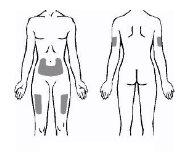
- Для каждой новой инъекции должно использоваться другое место. Каждая новая инъекция должна находиться не менее чем в 3 см от предыдущего места инъекции. НЕвводите инъекцию в чувствительные, ушибленные, покрасневшие или уплотненные участки кожи. Избегайте участков с рубцами или растяжками. (Возможно, будет полезно, если вы запишете места предыдущих инъекций).
- Если у вас или ребенка есть псориаз, необходимо попытаться не вводить инъекцию непосредственно в любые приподнятые, толстые, покрасневшие или чешуйчатые участки кожи (псориатические поражения кожи).
Шаг 3: Введение раствора Энбреля
- Очистите место инъекции ватным шариком с алкоголем, используя круговое движение. НЕприкасайтесь к этому участку до тех пор, пока не будет введена инъекция.
- Возьмите предварительно заполненный шприц с рабочей поверхности. Снимите колпачок с иглы, потянув его прямо (см. Фигуру 2). Будьте осторожны, чтобы не согнуть или повернуть колпачок при его снятии, чтобы не повредить иглу.
При снятии колпачка с иглы может появиться капля жидкости на конце иглы; это нормально. Не прикасайтесь к игле и избегайте ее соприкосновения с любой поверхностью. Не прикасайтесь и не трясите поршень. Если вы это сделаете, жидкость может пролиться.
Фигура 2
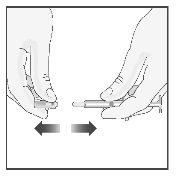
- Когда предварительно очищенный участок кожи высохнет, возьмите его и крепко удерживайте одной рукой. Другой рукой держите шприц, как карандаш.
- С помощью быстрого и короткого движения, введите иглу до конца, проникая в кожу под углом 45-90 градусов (см. Фигуру 3). С практикой вы найдете угол, который более комфортен для вас или ребенка. Будьте осторожны, чтобы не вводить иглу слишком медленно или с большой силой.
Фигура 3
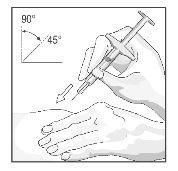
- Когда игла полностью введена в кожу, отпустите кожу, которую вы держите. Другой рукой держите иглу возле ее основания, чтобы стабилизировать ее. Затем нажмите на поршень, чтобы ввести весь раствор с медленной и постоянной скоростью (см. Фигуру 4).
Фигура 4
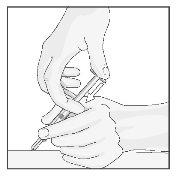
- Когда шприц будет пуст, выньте иглу из кожи; будьте осторожны, чтобы держать шприц под тем же углом, что и при введении. Может произойти легкое кровотечение в месте инъекции. Вы можете прижать вату или марлю к месту инъекции на 10 секунд. Не трите место инъекции. Если необходимо, можно накрыть место инъекции бинтом.
Шаг 4: Утилизация материалов
- Предварительно заполненный шприц используется исключительно для одной инъекции. Шприц и игла НИКОГДАне должны повторно использоваться. НИКОГДАне накрывайте иглу снова. Утилизируйте иглу и шприц, следуя инструкциям вашего врача, медсестры или фармацевта.
Если у вас есть какие-либо вопросы, проконсультируйтесь с врачом, медсестрой или фармацевтом, знакомыми с использованием Энбреля.
- Страна регистрации
- Активное вещество
- Требуется рецептДа
- Производитель
- Информация носит справочный характер и не является медицинской рекомендацией. Перед приемом любых препаратов проконсультируйтесь с врачом. Oladoctor не несет ответственности за медицинские решения, принятые на основе этого контента.
- Аналоги ЭНБРЕЛЬ 25 мг РАСТВОР ДЛЯ ИНЪЕКЦИЙ В ПРЕДНАПОЛНЕННЫХ ШПРИЦАХФорма выпуска: ИНЪЕКЦИОННЫЙ РАСТВОР, 25 мгАктивное вещество: ЭтанерцептПроизводитель: Samsung Bioepis Nl B.V.Требуется рецептФорма выпуска: ИНЪЕКЦИОННЫЙ, 50 мгАктивное вещество: ЭтанерцептПроизводитель: Samsung Bioepis Nl B.V.Требуется рецептФорма выпуска: ИНЪЕКЦИОННЫЙ РАСТВОР, 50 мгАктивное вещество: ЭтанерцептПроизводитель: Samsung Bioepis Nl B.V.Требуется рецепт
Аналоги ЭНБРЕЛЬ 25 мг РАСТВОР ДЛЯ ИНЪЕКЦИЙ В ПРЕДНАПОЛНЕННЫХ ШПРИЦАХ в других странах
Лучшие аналоги с тем же действующим веществом и терапевтическим эффектом.
Аналог ЭНБРЕЛЬ 25 мг РАСТВОР ДЛЯ ИНЪЕКЦИЙ В ПРЕДНАПОЛНЕННЫХ ШПРИЦАХ в Украина
Врачи онлайн по ЭНБРЕЛЬ 25 мг РАСТВОР ДЛЯ ИНЪЕКЦИЙ В ПРЕДНАПОЛНЕННЫХ ШПРИЦАХ
Консультация по дозировке, побочным эффектам, взаимодействиям, противопоказаниям и продлению рецепта на ЭНБРЕЛЬ 25 мг РАСТВОР ДЛЯ ИНЪЕКЦИЙ В ПРЕДНАПОЛНЕННЫХ ШПРИЦАХ – по решению врача и с учетом местных правил.



